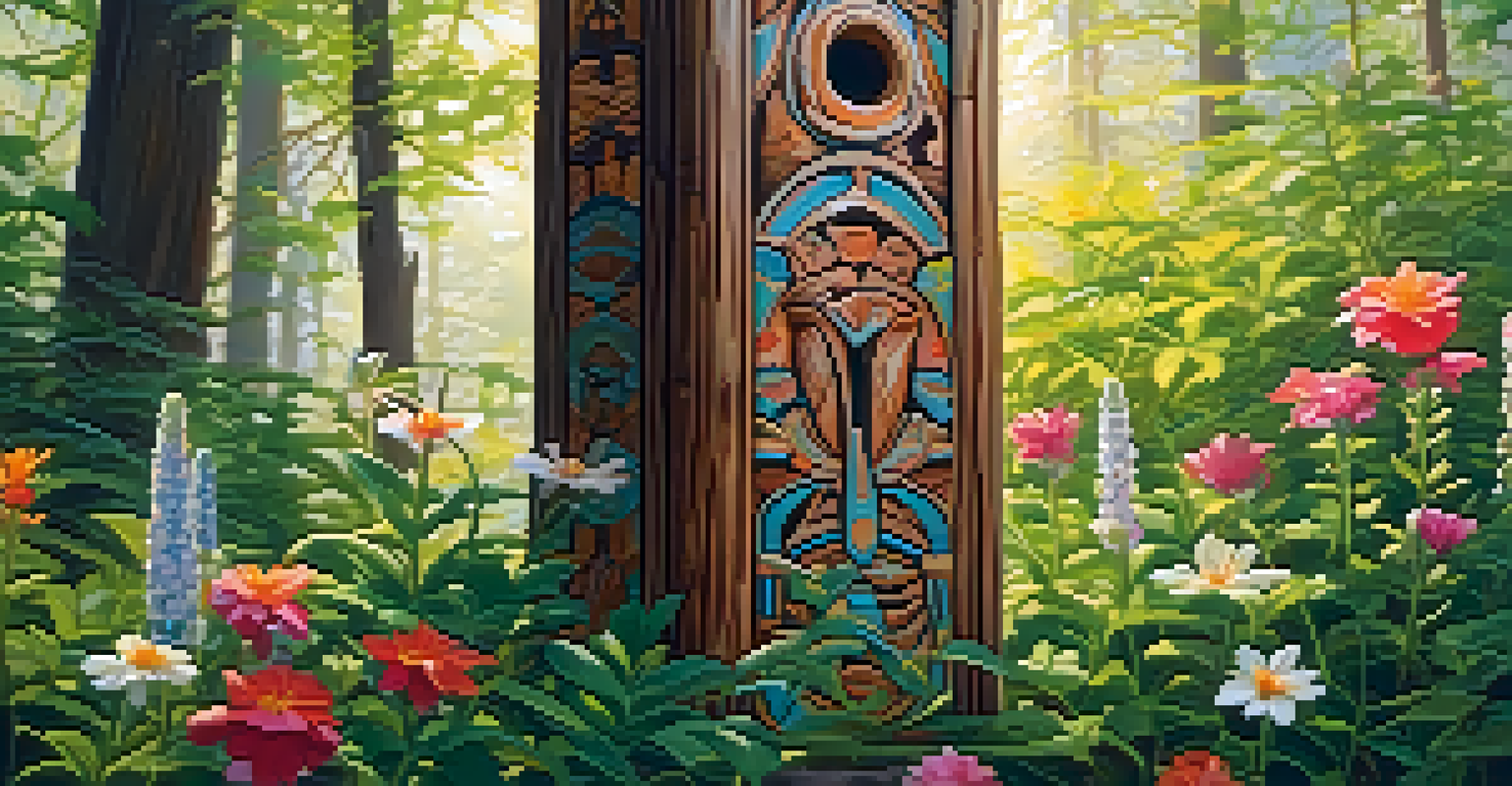Incorporating Cultural Symbolism through Landscaping Carvings

Understanding Cultural Symbolism in Landscaping
Cultural symbolism involves using specific elements to convey ideas or beliefs. In landscaping, this can mean employing shapes, materials, and designs that resonate with a particular culture. For example, using native plants or traditional motifs can infuse a garden with deeper meaning beyond its visual appeal.
Landscapes are the backdrop of our lives, and the stories they tell are woven into the very fabric of our culture.
Landscaping is not just about aesthetics; it’s a way to tell stories and celebrate heritage. Carvings, whether in wood, stone, or other materials, can represent myths, values, or even historical events. Therefore, understanding the cultural background is crucial when choosing symbols for landscaping.
When you incorporate cultural symbolism, you engage visitors on a more profound level. It invites them to not only appreciate the beauty of the landscape but also to explore the stories behind the designs, creating a richer experience for everyone.
Choosing the Right Symbols for Your Landscape
Selecting the appropriate symbols is key to creating a meaningful landscape. Start by researching the cultural significance of various symbols, ensuring they align with the message you want to convey. For instance, a lotus flower might symbolize purity in many Asian cultures, making it a thoughtful addition to a garden.

Consider the emotional impact of different symbols. Some symbols might evoke feelings of tranquility, strength, or community. By carefully choosing symbols that resonate emotionally, you can create a landscape that feels welcoming and authentic.
Cultural Symbols Enhance Landscapes
Incorporating cultural symbolism in landscaping creates deeper meanings and stories that resonate with visitors.
It's also important to consider the visual harmony of the symbols with the overall design of your landscape. A well-integrated symbol can enhance the beauty of the space, while a poorly placed one might detract from it. Balance is essential for a cohesive look.
Materials and Techniques for Carvings
The choice of materials plays a crucial role in the longevity and impact of landscaping carvings. Stone, wood, and metal each offer unique aesthetic qualities and durability. For example, granite carvings can withstand the elements, making them ideal for outdoor settings.
Art is a reflection of the culture from which it comes, and every garden can be a living piece of art that tells a story.
In terms of techniques, consider both traditional and modern methods. Hand-carved designs often carry a sense of authenticity and craftsmanship, while laser-cut designs can achieve intricate details with precision. Each technique has its own charm, contributing to the overall feel of the landscape.
Regardless of the method chosen, ensure that the craftsmanship reflects the cultural significance of the symbols. High-quality work not only enhances the landscape but also honors the culture being represented, creating a respectful and engaging environment.
Incorporating Local Flora with Symbolic Carvings
Integrating local flora with symbolic carvings creates a harmonious landscape that celebrates both nature and culture. Native plants often hold cultural significance, acting as living representations of a community’s heritage. For example, using cedar trees in a Native American garden can symbolize strength and resilience.
By pairing these plants with carvings that reflect cultural stories or values, you create a dynamic dialogue between flora and symbolism. This approach not only beautifies the space but also educates visitors about the local ecosystem and its ties to cultural identity.
Community Involvement is Key
Engaging local artists and residents in the design process fosters a sense of pride and ownership in the landscape.
Moreover, local flora can enhance the carvings by providing context and depth. Imagine a beautifully carved totem standing tall amidst native shrubs and flowers; the combination tells a richer story than either element could alone.
Creating a Narrative Through Landscape Design
Every landscape has a story to tell, and using cultural symbolism in carvings can enhance that narrative. This storytelling aspect invites visitors to engage more deeply with the space. Think of a garden laid out to depict a journey through a particular culture’s history, with each carving marking a significant milestone.
Incorporating elements like pathways or seating areas can guide visitors through this narrative, allowing them to absorb the cultural significance at their own pace. Each carving becomes a chapter in the story, inviting exploration and reflection.
When people connect with the narrative behind the landscape, it fosters a sense of belonging and appreciation. This emotional connection can transform a simple garden into a powerful tribute to culture and identity.
Maintenance and Preservation of Carvings
Maintaining the integrity of landscaping carvings is essential for preserving their cultural significance. Weather elements can take a toll on materials, so regular upkeep is vital. For instance, wooden carvings may require treatment to prevent rot, while stone may need cleaning to preserve its appearance.
In addition to physical maintenance, it’s important to educate the community about the significance of these carvings. Engaging local groups in the care of the landscape fosters a sense of ownership and responsibility, ensuring that the cultural stories embedded in the carvings are honored.
Maintenance Preserves Cultural Significance
Regular upkeep and community education are essential for maintaining the integrity and cultural narratives of landscaping carvings.
Furthermore, documenting the history and meaning of the carvings can help preserve their significance for future generations. Creating informational plaques or community events around the landscape can keep the cultural narratives alive and relevant.
Engaging the Community in Landscape Design
Community involvement in landscape design can enhance the incorporation of cultural symbolism. Engaging local artists, historians, and residents in the design process ensures that the symbols chosen resonate with the community’s identity. This collaborative approach fosters a sense of pride and ownership in the space.
Workshops and discussions can be excellent platforms for gathering input and ideas. By encouraging community members to share their cultural stories and preferences, you create a landscape that truly reflects the collective identity.

Ultimately, when the community has a hand in creating the landscape, the result is a vibrant space that honors its cultural roots while serving as a gathering point for future generations.